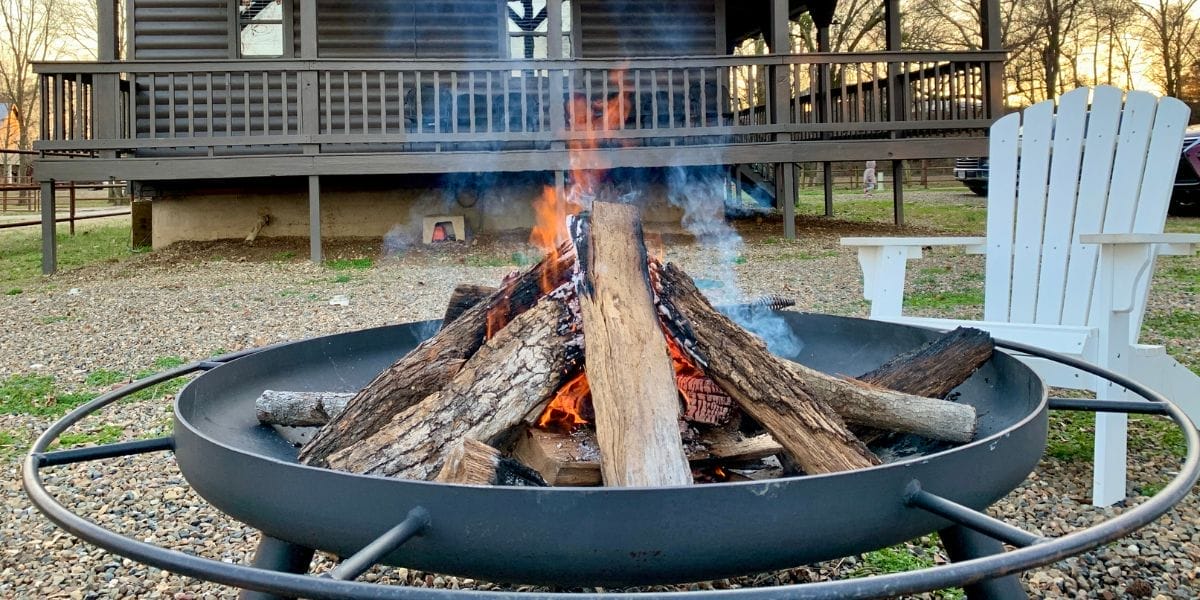

Uh oh...
It appears that you're using a severely outdated version of Safari on Windows. Many features won't work correctly, and functionality can't be guaranteed. Please try viewing this website in Edge, Mozilla, Chrome, or another modern browser. Sorry for any inconvenience this may have caused!
Read More about this safari issue.

Just because Halloween is over doesn’t mean there isn’t still space for spooky stories around the campfire. And who’s to say a campfire story has to be spooky? My son and his cousin recently found time to work on campfire stories while hanging out with extended family at an Arkansas State Park.
As two kids learning to build stories, I was mesmerized hearing them tell “creepy and spooky” stories. Now, neither of them spends a lot of time camping, so neither has listened to many campfire stories. But somewhere along the way, they heard, watched, and tried to mimic a sacred tradition of fall…campfire stories.

These are the kind of tall tales that are built, partially truth and partially fiction, to engage listeners more. Surrounding sounds and landmarks are often woven into the narrative, and the exaggeration grows each time a similar story is shared. The next storyteller always tries to “one up” the original message first declared by flickering firelight.
Here’s a step-by-step guide to help you craft and share captivating tales fireside or in the dark of your own home if you camp as I do!
Set the Scene
Before starting story time, create a cozy atmosphere that encourages connection. Gather your group around the campfire, ensuring everyone can see and hear you. If you are camping indoors, dim the surrounding lights, if possible, to enhance the ambiance. Encourage participants to relax and enjoy the warmth of the fire, which can help set the mood for your stories. Wait until all the cleanup and evening activities are over, then gather the group tight so you can captivate them without distractions.

Choose the Right Story
Selecting the right story is crucial to engaging your audience. Consider the following types of stories:
- Folklore and Legends: Classic tales from different cultures can captivate listeners. These stories often have moral lessons and rich imagery. And, are told to the best of your memory. If you know this will be part of your camping experience, plan and do background research so you don’t get called for a fact check!
- Spooky Stories: A ghost story can be thrilling if your audience is in the mood for chills. Just gauge your audience’s comfort level! And remember, a made-up story is usually the best, especially if you can play off the chilling facts you know your listeners will enjoy.
- Adventure Tales: Exciting stories filled with action and adventure can keep everyone on the edge. These are fun to tell in different parts over multiple nights. Or, if you are making this up as you go, leave it on a cliffhanger and see if someone around the campfire can pick up the story and run with it!
- Personal Anecdotes: Share a funny or meaningful experience from your own life. Personal stories often resonate more deeply and can spark conversations. If the stories are sorrowful, they can also bring a heavy mood, so be prepared to navigate the tough topics.
Know Your Audience
Tailor your storytelling approach to the age and interests of your audience. For children, keep stories light-hearted and fun and give them a chance to participate. Younger children will mimic section by section the type of story they hear first, so set them up for fun!
For adults or teens, dive into more complex themes or slightly darker tales. Knowing your audience will help you choose the right tone, language and content for your stories.
Build the Narrative
A good story has a clear structure. Most authors will tell you this is the pattern they follow to write a book, especially those chillers, thrillers and cozy mysteries:
- Introduction: Set the stage with a captivating opening. Introduce the characters and the setting to draw listeners in.
- Conflict: Every story needs some tension or conflict. Present a challenge or dilemma that the characters must face. Do they disagree? Do they get lost? Do they lose an item? Do they hear a strange noise? Do they realize they are being followed? Are they trapped or blocked in?
- Climax: Build up to the most exciting part of the story. This is where the action peaks and the listeners should be most engaged. You want everyone on the edge of their seat, leaning in close to figure out what happens next.
- Resolution: Conclude the story with a satisfying ending. Tie up any loose ends and consider adding a moral or lesson learned. Maybe the resolution is all you need, but after you take listeners on that journey, do your characters a favor and finish the story, even if it’s not a happy ending!
Use Engaging Delivery Techniques
How you tell the story is just as important as the story itself. Here are some tips for engaging delivery:
- Voice Modulation: Vary your tone, volume, and pace to match the story’s mood. Use a soft voice for suspenseful moments and a loud, booming voice for dramatic ones.
- Accents Separate Characters: Change your tone when different characters are talking, or try your best at a handful of accents. “Arkansas hillbilly” usually works well if you are sitting in the woods. A deep-voiced, authoritative Park Ranger is appropriate when you are in a state park. Then “mother-in-law” works for an “I told you so” moment, and “whiney preschooler” is fun when talking about the kids!
- Facial Expressions and Gestures: Use your body language to convey emotions and actions. Lean in during tense moments or widen your eyes for surprise. Spread your arms or use a blanket to make shadows dance around you.
- Eye Contact: Make eye contact with your audience to create a connection. This helps keep them engaged and makes them feel involved in the story.
- Pauses: Take your time with the story. Use pauses effectively to build suspense or allow key moments to resonate with your listeners. (This also gives you space to build your story!)
- Use a cliffhanger: A dramatic open ending to a story can keep your listeners returning for more. Don’t leave them worried so they can still sleep tonight, but don’t tell them all the details if you stay together for more than one night. The suspense is crucial in keeping attention and getting them back around the fire for another night.
Encourage Participation
To enhance the campfire storytelling experience, invite your audience to participate. This could include:
- Story Continuation: Invite others to add twists or continue the tale after finishing your story.
- Questions and Discussion: Encourage listeners to ask questions or share their thoughts about the story afterward. This can lead to lively discussions and deeper connections.
- Characters: Use your listeners to voice your characters. Assign them before you start, or call them out as you go. It’s always fun to break up the monotony of a narrator with a new voice.
Create a Campfire Tradition
Consider making storytelling a regular part of your campfire gatherings. Establishing a tradition encourages everyone to contribute their stories over time, fostering creativity and connection within the group. For many families who camp, it’s a rite of passage to take the story of a story you heard as a child and amplify it for a new generation.
Telling campfire stories is a beautiful way to bond with friends and family, ignite imagination and create lasting memories. You can include children, help them push their imagination and use the storytelling tools they learn in school. Whether you are camping or in your backyard, spark up the campfire and let the stories unfold!
We do the work.
You check your email.
Sign up for our weekly e-news.
Get stories sent straight to your inbox!











Like this story? Read more from Keisha Pittman McKinney
The holidays have a way of bringing us together - around food, laughter,...
Oh my goodness… there’s no cinnamon-roll story more special in...
Every year, as we unpack our Christmas boxes, stories unfold with each...
Join the Conversation
Leave a Comment